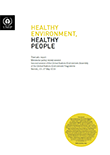 23 May 2016: Environmental degradation and pollution cause almost a quarter of all deaths, up to 234 times as many premature deaths as occur in conflicts annually and the deaths of more than 25% of all children under the age of five, according to a UN report released to coincide with the second session of the UN Environment Assembly (UNEA-2). The report, titled ‘Healthy Environment, Healthy People,’ emphasizes the importance of a healthy environment to achieving the 2030 Agenda for Sustainable Development and addresses dangers posed by air pollution, chemicals, climate change and other issues linking environmental quality to health.
23 May 2016: Environmental degradation and pollution cause almost a quarter of all deaths, up to 234 times as many premature deaths as occur in conflicts annually and the deaths of more than 25% of all children under the age of five, according to a UN report released to coincide with the second session of the UN Environment Assembly (UNEA-2). The report, titled ‘Healthy Environment, Healthy People,’ emphasizes the importance of a healthy environment to achieving the 2030 Agenda for Sustainable Development and addresses dangers posed by air pollution, chemicals, climate change and other issues linking environmental quality to health.
The report finds that in 2012, an estimated 12.6 million deaths were attributable to deteriorating environment conditions, with the highest proportion occurring in Southeast Asia and in the Western Pacific, followed by Sub-Saharan Africa. Deaths related to non-communicable diseases (NCDs) are rising in all regions.
In a discussion on what is impacting or driving such trends, the report points to ecosystem disruption, climate change, inequality, unplanned urbanization, unhealthy and wasteful lifestyles, and unsustainable consumption and production (SCP) patterns. The publication highlights, in particular, that climate change is exacerbating the scale and intensity of environment-related health risks, with the WHO estimating that 250,000 additional deaths could occur annually between 2030 and 2050 from climate-induced malnutrition, malaria, diarrhea and heat stress.
The report also explains that: air pollution kills seven million people annually, with 4.3 million of those deaths from household air pollution; lack of access to clean water and sanitation results in 842,000 deaths annually from diseases that cause diarrhea, which are the third leading cause of deaths of children younger than five; approximately 107,000 people die annually from asbestos exposure, and 654,000 died from lead exposure in 2010; and natural disasters have led to 606,000 deaths since 1995.
The report then goes on to illustrate how investing in a healthy environment can bring multiple benefits. For example, by phasing out nearly 100 ozone-depleting substances (ODS) up to two million cases of skin cancer and millions of eye cataracts may be prevented each year. In addition, eliminating lead in gasoline has prevented an estimated one million premature deaths per year, and reducing emissions of short-lived climate pollutants, such as black carbon and methane, could reduce global warming by 0.5°C by mid-century, and save 2.4 million lives a year by 2030.
To achieve these benefits, the report recommends: detoxification and removing harmful substances from and/or mitigating their impact on the environment; decarbonization and increased use of renewables; decoupling resource use and changing lifestyles; and enhancing ecosystem resilience and protecting natural systems, including protecting and conserving genetic diversity and terrestrial, coastal and marine biodiversity; strengthening ecosystem restoration; and reducing pressures from livestock production and logging on natural ecosystems. [Publication: Healthy Environment, Healthy People] [UNEP Press Release] [IISD RS Coverage of UNEA-2]